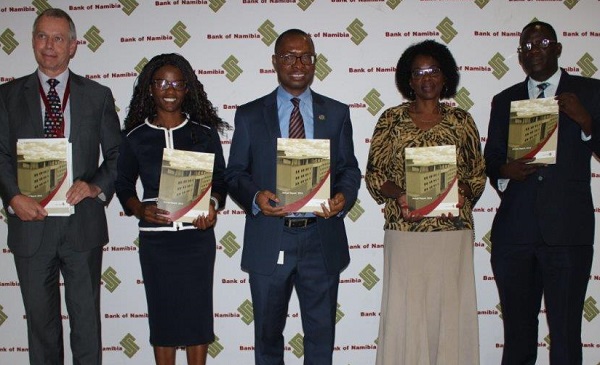
Bank of Namibia paid government N$68 million in dividends for 2016

When the Bank of Namibia Governor, Ipumbu Shiimi released the bank’s Annual Report last Friday, he said the state revenued fund received just over N$68 million from the bank in 2016 as dividend payments to the government as its only shareholder.
The Bank of Namibia’s 2016 Annual Report was made available to the public on Friday 31 March 2017. The report provides an overview of the cental bank and its operations, overviews of domestic, regional and international trading conditions, and a review of the Namibian banking sector.
As customary, the report includes a chapter dealing with the activities of the central bank’s Banking Supervision, which largely focuses on the stability and soundness of Namibia’s banking system.
Furthermore, this edition includes a Theme Chapter on the topic “The impact of the decline in commodity prices on the Namibian economy post 2008”. lt concludes that the low commodity prices have affected the Namibian economy largely via the trade channel and government revenue.
This necessitated fiscal consolidation, which affected the construction and public administration sectors.
The last section of the report presents statistical tables, which give more information on economic and financial statistics for the past five years.
The Bank’s audited Annual Financial Statements reflect the financial position of the bank, its financial performance, and cash flows for the year.
The central bank’s financial performance improved in 2016 compared to the previous financial year. An improvement in the interest rate environment in certain capital markets, resulted in higher returns on the bank’s investment portfolios. A revised investment strategy which focused on investments in specific markets, and prudent management of operational costs, further contributed to the improved financial performance.
The Bank tightened monetary policy during 2016, to align interest rates with that of South Africa.
The repo rate was raised twice by 25 basis points, first to 6.75% and then to 7% in April last year.
Growth in broad money supply slowed to 4.9% in 2016 compared to 10.2% in 2015, mainly due to the decline in net foreign assets of other depository corporations, coupled with slower growth in credit extended to the private sector.
Growth in Private Sector Credit Extension slowed to 8.9% at the end of 2016, down from 13.5% in 2015 due to lower demand for credit by the corporate sector and by private households.
During 2016, Namibia’s external balance recorded a reduced surplus from a significant surplus in 2015, mainly due to decreased capital inflows on the capital and financial account. The overall surplus was N$0.9 billion during 2016, dropping sharply from a surplus of N$10.0 billion in 2015.
“The lower surplus should be viewed as normalisation of the external balance as the 2015 position was an exception caused by a large Eurobond issue. Meanwhile, the current account deficit improved during the year under review, mainly as a result of a significant increase in export earnings relative to import payments” according to the Annual Report.
Finally, international reserves rose in 2016 and remained sufficient to sustain the one-to one currency peg with the South African Rand. The level of international reserves increased by 4.8% to N$24.7 billion at the end of 2016, from N$23.6 billion a year earlier. The latest value is 5.6 times the value of currency in circulation, supporting the reserve adequacy ratio as per the one to one link.
Full report at https://www.bon.com.na/Publications/AnnualReports










































